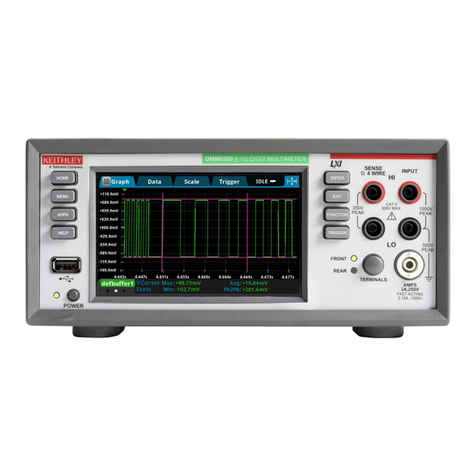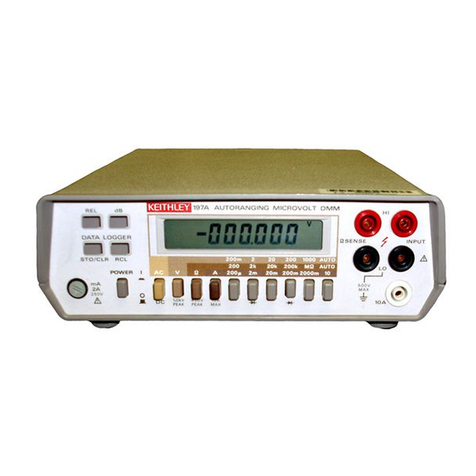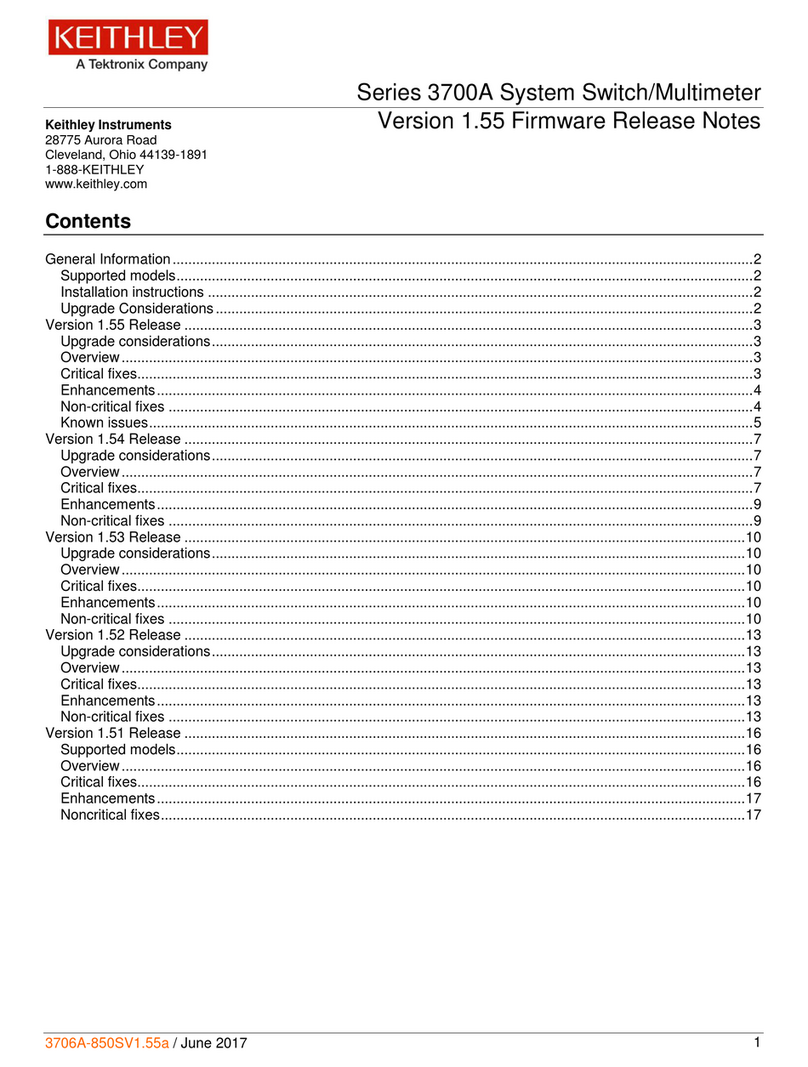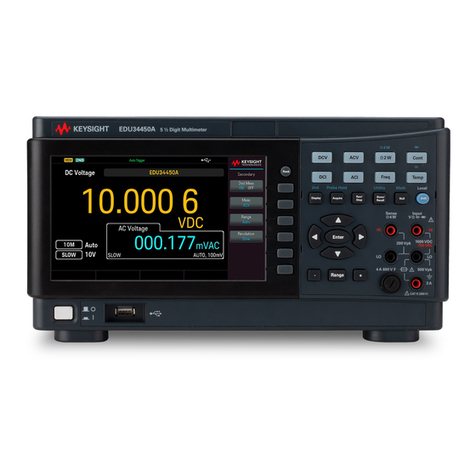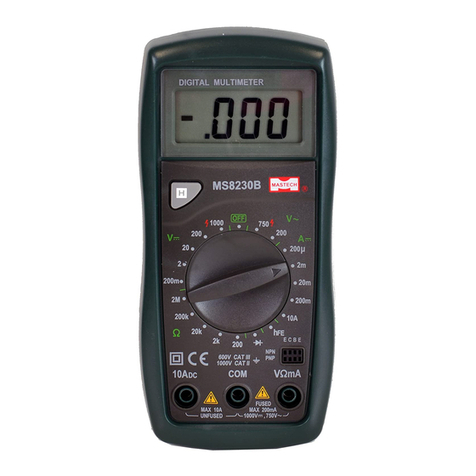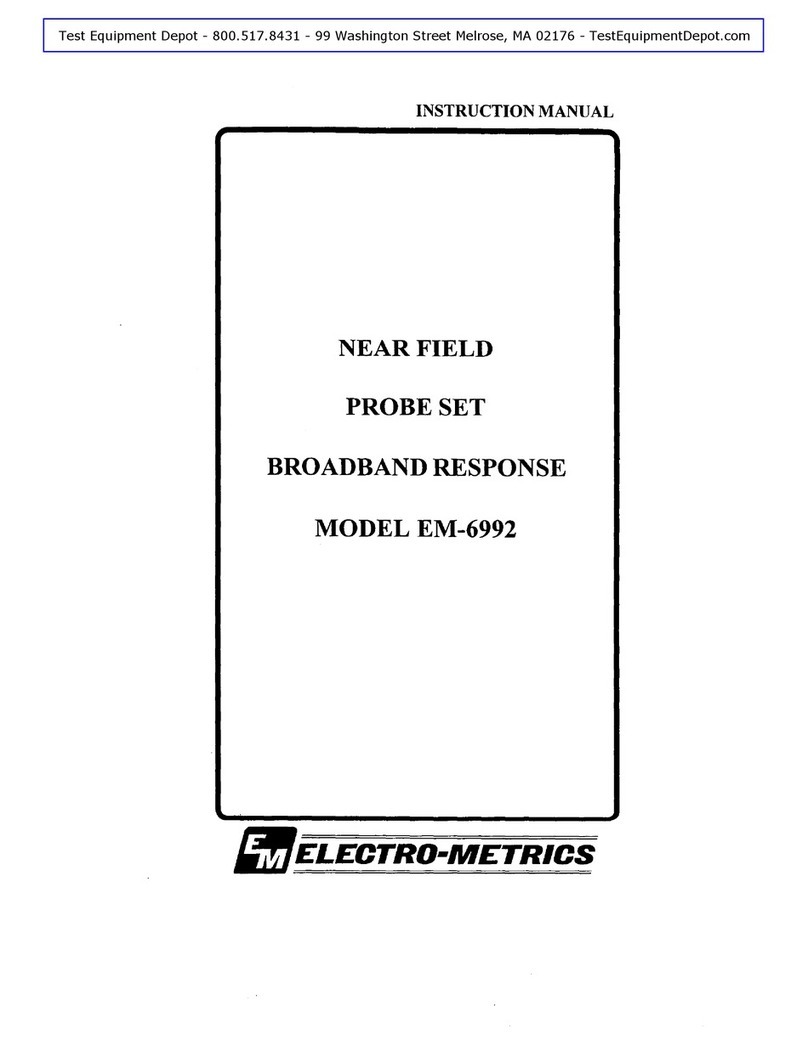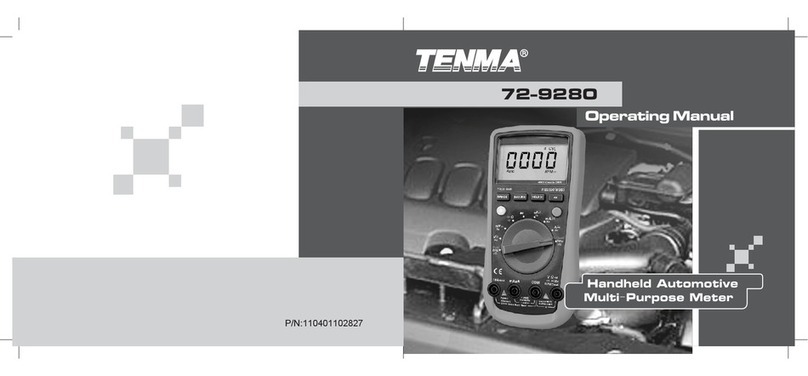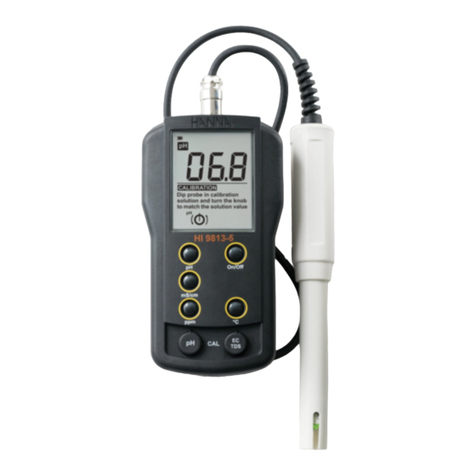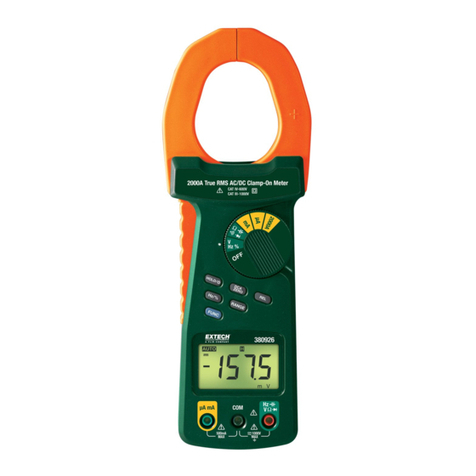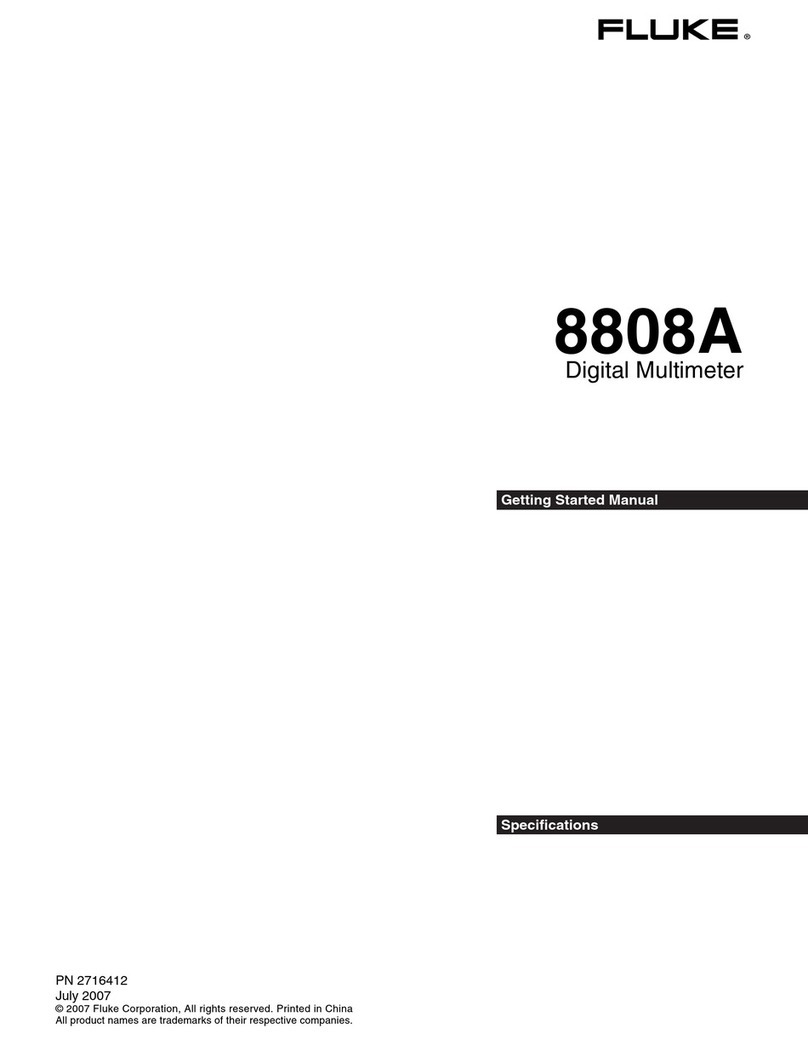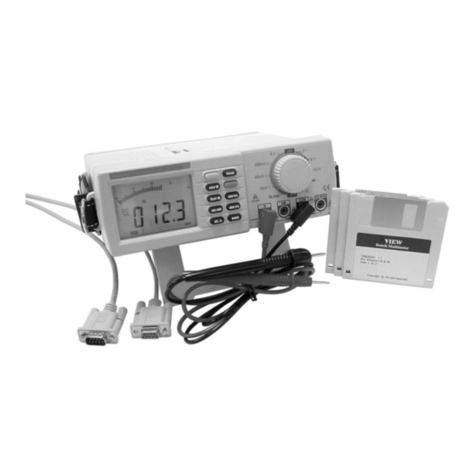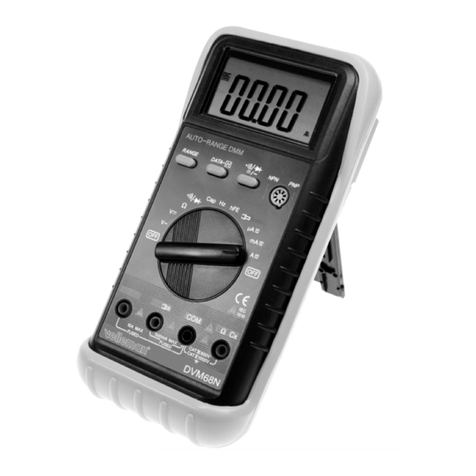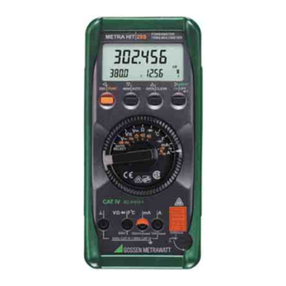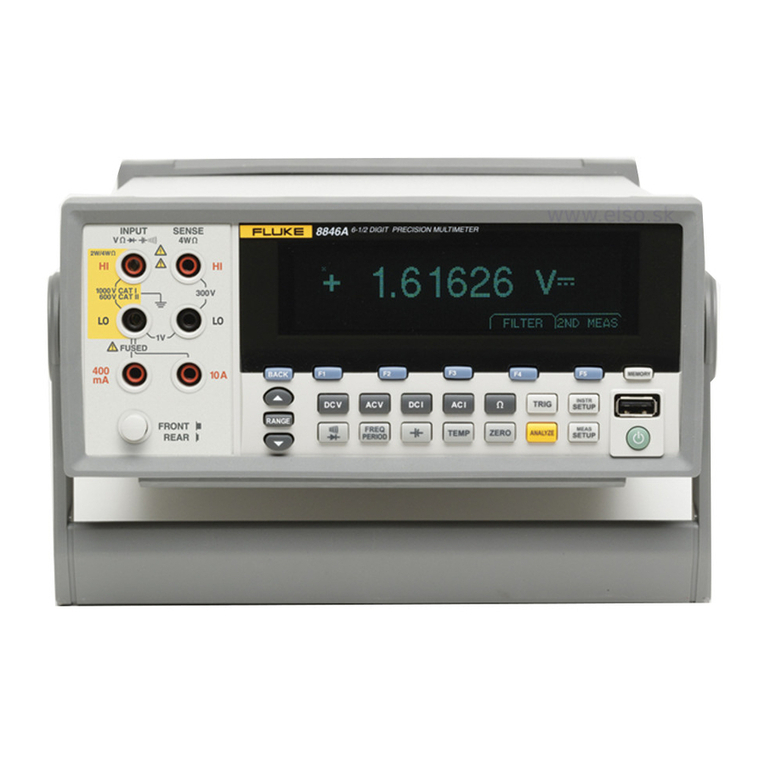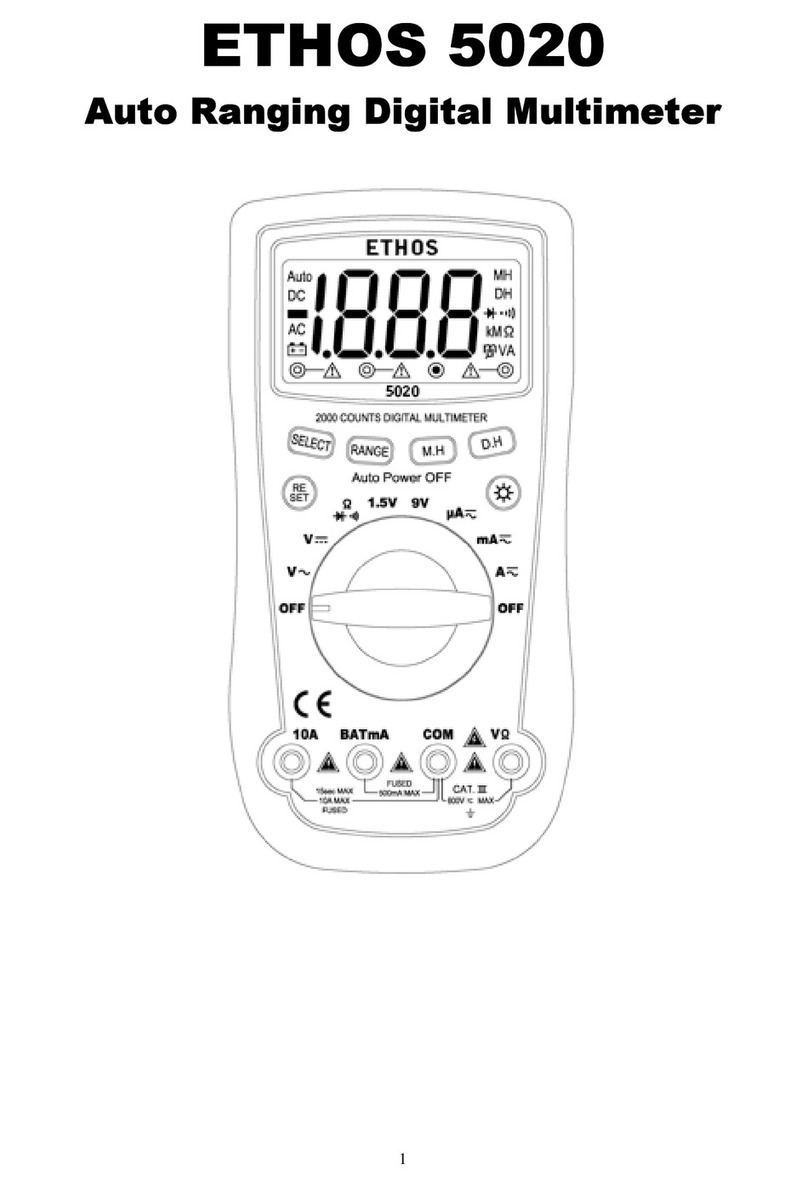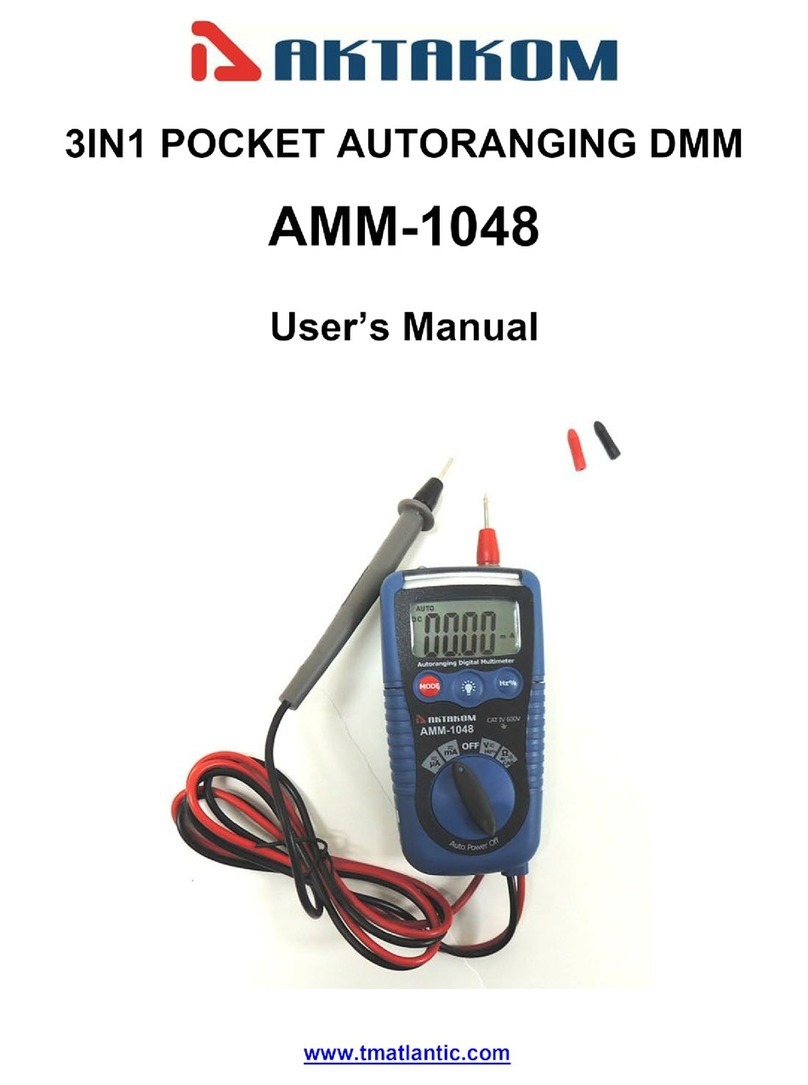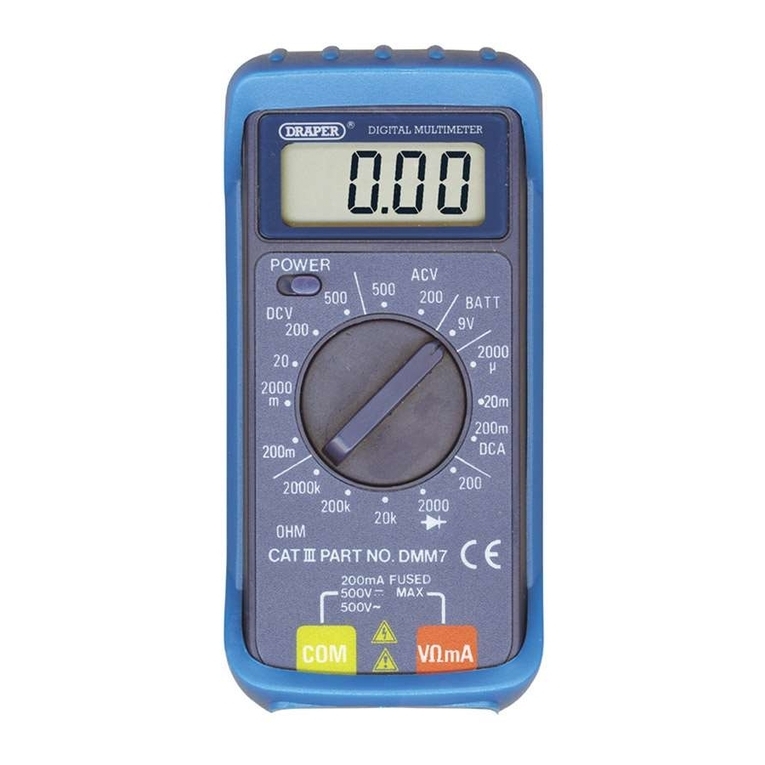Keithley 2015 User manual

Contains Servicing Information
Model 2015
THD Multimeter
Service Manual
2015 THD MULTIMETER
RANGE
!
F
500V
PEAK
FRONT/REAR 3A250V
AMPS
HI INPUT
LO
SENSE
Ω4 WIRE
INPUTS
350V
PEAK 1000V
PEAK
AUTO
SHIFT
LOCAL
POWER
RANGE
R
SHIFT
CH1REM
TALK
LSTN
SRQ
STAT
REL FILT
4W
BUFFER
MATH
REAR
SCAN
TIMER
STEP CH2 CH3 CH4 CH5 CH6 CH7 CH8 CH9 CH10
HOLD TRIG FAST MED SLOW AUTO ERR
EXIT ENTER
DIGITS RATE
RELFILTER
TRIG
EX TRIG
STORE
RECALL
SOURCE
MEAS
DCV DCI
MATH
THD
dBm
ACV
ACI Ω2Ω4
FREQ
TEMP
dB
CONT
PERIOD TCOUPL
LIMITS ON/OFFDELAY HOLD
SAVE SETUP CONFIG HALT
TEST
RS232
GPIB
CAL
STEP SCAN
THD

WARRANTY
Keithley Instruments, Inc. warrants this product to be free from defects in material and workmanship for a
period of 3 years from date of shipment.
Keithley Instruments, Inc. warrants the following items for 90 days from the date of shipment: probes,
cables, rechargeable batteries, diskettes, and documentation.
During the warranty period, we will, at our option, either repair or replace any product that proves to be
defective.
To exercise this warranty, write or call your local Keithley representative, or contact Keithley headquarters in
Cleveland, Ohio. You will be given prompt assistance and return instructions. Send the product, transporta-
tion prepaid, to the indicated service facility. Repairs will be made and the product returned, transportation
prepaid. Repaired or replaced products are warranted for the balance of the original warranty period, or at
least 90 days.
LIMITATION OF WARRANTY
This warranty does not apply to defects resulting from product modification without Keithley’s express writ-
ten consent, or misuse of any product or part. This warranty also does not apply to fuses, software, non-
rechargeable batteries, damage from battery leakage, or problems arising from normal wear or failure to fol-
low instructions.
THIS WARRANTY IS IN LIEU OF ALL OTHER WARRANTIES, EXPRESSED OR IMPLIED,
INCLUDING ANY IMPLIED WARRANTY OF MERCHANTABILITY OR FITNESS FOR A PARTICU-
LAR USE. THE REMEDIES PROVIDED HEREIN ARE BUYER’S SOLE AND EXCLUSIVE REME-
DIES.
NEITHER KEITHLEY INSTRUMENTS, INC. NOR ANY OF ITS EMPLOYEES SHALL BE LIABLE
FOR ANY DIRECT, INDIRECT, SPECIAL, INCIDENTAL OR CONSEQUENTIAL DAMAGES ARIS-
ING OUT OF THE USE OF ITS INSTRUMENTS AND SOFTWARE EVEN IF KEITHLEY INSTRU-
MENTS, INC., HAS BEEN ADVISED IN ADVANCE OF THE POSSIBILITY OF SUCH DAMAGES.
SUCH EXCLUDED DAMAGES SHALL INCLUDE, BUT ARE NOT LIMITED TO: COSTS OF
REMOVALAND INSTALLATION, LOSSES SUSTAINEDAS THE RESULT OF INJURY TO ANY PER-
SON, OR DAMAGE TO PROPERTY.
1/99

Model 2015 THD Multimeter
Service Manual
©1998, Keithley Instruments, Inc.
All rights reserved.
Cleveland, Ohio, U.S.A.
Third Printing, June 1999
Document Number: 2015-902-01 Rev. C

Manual Print History
The print history shown below lists the printing dates of all Revisions and Addenda created
for this manual. The Revision Level letter increases alphabetically as the manual undergoes sub-
sequent updates.Addenda, which are released between Revisions, contain important change in-
formation that the user should incorporate immediately into the manual.Addenda are numbered
sequentially.WhenanewRevision is created, allAddendaassociatedwith the previousRevision
of the manual are incorporated into the new Revision of the manual. Each new Revision includes
a revised copy of this print history page.
RevisionA (Document Number 2015-902-01) .................................................................May 1998
Revision B (Document Number 2015-902-01)..................................................................July 1998
Revision C (Document Number 2015-902-01).................................................................June 1999
All Keithley product names are trademarks or registered trademarks of Keithley Instruments, Inc.
Other brand names are trademarks or registered trademarks of their respective holders.

Safety Precautions
The following safety precautions should be observed before using this product and any associated instrumen-
tation.Although some instruments and accessories would normally be used with non-hazardous voltages, there
are situations where hazardous conditions may be present.
This product is intended for use by qualified personnel who recognize shock hazards and are familiar with the
safety precautions required to avoid possible injury. Read the operating information carefully before using the
product.
The types of product users are:
Responsiblebody
is the individual or group responsible for the use and maintenance of equipment, for ensuring
that the equipment is operated within its specifications and operating limits, and for ensuring that operators are
adequately trained.
Operators
use the product for its intended function. They must be trained in electrical safety procedures and
proper use of the instrument. They must be protected from electric shock and contact with hazardous live circuits.
Maintenance personnel
perform routine procedures on the product to keep it operating, for example, setting
the line voltage or replacing consumable materials. Maintenance procedures are described in the manual. The
procedures explicitly state if the operator may perform them. Otherwise, they should be performed only by ser-
vice personnel.
Service personnel
are trained to work on live circuits, and perform safe installations and repairs of products.
Only properly trained service personnel may perform installation and service procedures.
Exercise extreme caution when a shock hazard is present. Lethal voltage may be present on cable connector
jacks or test fixtures. TheAmerican National Standards Institute (ANSI) states that a shock hazard exists when
voltage levels greater than 30V RMS, 42.4V peak, or 60VDC are present.
A good safety practice is to expect
that hazardous voltage is present in any unknown circuit before measuring.
Users of this product must be protected from electric shock at all times. The responsible body must ensure that
users are prevented access and/or insulated from every connection point. In some cases, connections must be
exposed to potential human contact. Product users in these circumstances must be trained to protect themselves
from the risk of electric shock. If the circuit is capable of operating at or above 1000 volts,
no conductive part
of the circuit may be exposed.
As described in the International Electrotechnical Commission (IEC) Standard IEC 664, digital multimeter
measuring circuits (e.g., Keithley Models 175A, 199, 2000, 2001, 2002, and 2010) are Installation Category II.
All other instruments’signal terminals are Installation Category I and must not be connected to mains.
Do not connect switching cards directly to unlimited power circuits. They are intended to be used with imped-
ance limited sources. NEVER connect switching cards directly to AC mains. When connecting sources to
switching cards, install protective devices to limit fault current and voltage to the card.
Before operating an instrument, make sure the line cord is connected to a properly grounded power receptacle.
Inspect the connecting cables, test leads, and jumpers for possible wear, cracks, or breaks before each use.
For maximum safety, do not touch the product, test cables, or any other instruments while power is applied to
the circuit under test.ALWAYS remove power from the entire test system and discharge any capacitors before:
connecting or disconnecting cables or jumpers, installing or removing switching cards, or making internal
changes, such as installing or removing jumpers.
Do not touch any object that could provide a current path to the common side of the circuit under test or power
line (earth) ground. Always make measurements with dry hands while standing on a dry, insulated surface ca-
pable of withstanding the voltage being measured.

The instrument and accessories must be used in accordance with its specifications and operating instructions or
the safety of the equipment may be impaired.
Do not exceed the maximum signal levels of the instruments and accessories, as defined in the specifications
and operating information, and as shown on the instrument or test fixture panels, or switching card.
When fuses are used in a product, replace with same type and rating for continued protection against fire hazard.
Chassis connections must only be used as shield connections for measuring circuits, NOT as safety earth ground
connections.
If you are using a test fixture, keep the lid closed while power is applied to the device under test. Safe operation
requires the use of a lid interlock.
If a screw is present, connect it to safety earth ground using the wire recommended in the user documen-
tation.
The symbol on an instrument indicates that the user should refer to the operating instructions located in
the manual.
The symbol on an instrument shows that it can source or measure 1000 volts or more, including the com-
bined effect of normal and common mode voltages. Use standard safety precautions to avoid personal contact
with these voltages.
The
WARNING
heading in a manual explains dangers that might result in personal injury or death. Always
read the associated information very carefully before performing the indicated procedure.
The
CAUTION
heading in a manual explains hazards that could damage the instrument. Such damage may
invalidate the warranty.
Instrumentation and accessories shall not be connected to humans.
Before performing any maintenance, disconnect the line cord and all test cables.
To maintain protection from electric shock and fire, replacement components in mains circuits, including the
power transformer, test leads, and input jacks, must be purchased from Keithley Instruments. Standard fuses,
with applicable national safety approvals, may be used if the rating and type are the same. Other components
that are not safety related may be purchased from other suppliers as long as they are equivalent to the original
component. (Note that selected parts should be purchased only through Keithley Instruments to maintain accu-
racy and functionality of the product.) If you are unsure about the applicability of a replacement component,
call a Keithley Instruments office for information.
To clean an instrument, use a damp cloth or mild, water based cleaner. Clean the exterior of the instrument only.
Do not apply cleaner directly to the instrument or allow liquids to enter or spill on the instrument. Products that
consist of a circuit board with no case or chassis (e.g., data acquisition board for installation into a computer)
should never require cleaning if handled according to instructions. If the board becomes contaminated and op-
eration is affected, the board should be returned to the factory for proper cleaning/servicing.
!
Rev. 2/99

Table of Contents
1
Performance Verification
Introduction ........................................................................................ 1-2
Verification test requirements ............................................................ 1-3
Environmental conditions .............................................................. 1-3
Warm-up period ............................................................................. 1-3
Line power ..................................................................................... 1-3
Recommended test equipment ........................................................... 1-4
Verification limits ............................................................................... 1-5
Example reading limit calculation ................................................. 1-5
Calculating resistance reading limits ............................................. 1-5
Restoring factory defaults .................................................................. 1-6
Performing the verification test procedures ....................................... 1-7
Test summary ................................................................................. 1-7
Test considerations ......................................................................... 1-7
Verifying DC voltage ......................................................................... 1-8
Verifying AC voltage ....................................................................... 1-10
Verifying DC current ....................................................................... 1-12
Verifying AC current ........................................................................ 1-13
Verifying resistance ......................................................................... 1-14
Verifying temperature ...................................................................... 1-16
Verifying frequency ......................................................................... 1-17
Verifying total harmonic distortion .................................................. 1-18
Verifying function generator amplitude ........................................... 1-19
2
Calibration
Introduction ........................................................................................ 2-2
Environmental conditions .................................................................. 2-3
Warm-up period ............................................................................. 2-3
Line power ..................................................................................... 2-3
Calibration considerations ................................................................. 2-4
Calibration code ................................................................................. 2-5
Front panel calibration code ........................................................... 2-5
Remote calibration code ................................................................. 2-5
Comprehensive calibration ................................................................ 2-6
Calibration cycle ............................................................................ 2-6
Recommended equipment .............................................................. 2-6
Aborting calibration ....................................................................... 2-7
Front panel calibration ................................................................... 2-7
Preparing the Model 2015 for calibration ...................................... 2-7
Front panel short and open calibration ........................................... 2-8
DC volts calibration ....................................................................... 2-9

Resistance calibration .................................................................. 2-11
DC current calibration ................................................................. 2-12
AC voltage calibration ................................................................. 2-13
AC current calibration ................................................................. 2-14
Distortion calibration ................................................................... 2-14
Function generator calibration ..................................................... 2-15
Setting calibration dates and saving calibration .......................... 2-16
Remote calibration ....................................................................... 2-16
Preparing the Model 2015 for calibration .................................... 2-17
Short and open calibration ........................................................... 2-17
DC volts calibration ..................................................................... 2-18
Resistance calibration .................................................................. 2-19
DC current calibration ................................................................. 2-20
AC voltage calibration ................................................................. 2-21
AC current calibration ................................................................. 2-22
Distortion calibration ................................................................... 2-22
Function generator calibration ..................................................... 2-23
Programming calibration dates .................................................... 2-23
Saving calibration constants ........................................................ 2-23
Locking out calibration ................................................................ 2-23
Manufacturing calibration ............................................................... 2-24
Recommended test equipment ..................................................... 2-24
Unlocking manufacturing calibration .......................................... 2-24
Measuring synthesizer signal amplitude ...................................... 2-24
Front panel manufacturing calibration ......................................... 2-25
Remote manufacturing calibration .............................................. 2-26
3
Routine Maintenance
Introduction ....................................................................................... 3-2
Setting the line voltage and replacing the line fuse ....................... 3-2
Replacing the AMPS fuse .............................................................. 3-3
4
Troubleshooting
Introduction ....................................................................................... 4-2
Repair considerations ........................................................................ 4-3
Power-on self-test .............................................................................. 4-4
Front panel tests ................................................................................ 4-5
KEY test ......................................................................................... 4-5
DISP test ........................................................................................ 4-5
Principles of operation ...................................................................... 4-6
Power supply ................................................................................. 4-6
Display board ................................................................................. 4-8
Digital circuitry .............................................................................. 4-9

Analog circuitry ........................................................................... 4-11
Distortion digital circuitry ............................................................ 4-13
Distortion analog circuitry ........................................................... 4-15
Sine generator circuitry ................................................................ 4-16
Troubleshooting ............................................................................... 4-18
Display board checks ................................................................... 4-18
Power supply checks .................................................................... 4-19
Digital circuitry checks ................................................................ 4-20
Analog signal switching states ..................................................... 4-21
5
Disassembly
Introduction ........................................................................................ 5-2
Handling and cleaning ....................................................................... 5-3
Handling PC boards ....................................................................... 5-3
Solder repairs ................................................................................. 5-3
Static sensitive devices ................................................................... 5-4
Assembly drawings ............................................................................ 5-5
Disassembly procedures .................................................................... 5-6
Case cover removal ........................................................................ 5-6
DMM board removal ...................................................................... 5-6
DSP board removal ........................................................................ 5-7
Front panel disassembly ................................................................. 5-8
Removing power components ........................................................ 5-8
Instrument reassembly ....................................................................... 5-9
Input terminal wire connections ..................................................... 5-9
Power module wire connections .................................................... 5-9
Changing trigger link lines .............................................................. 5-10
Main CPU firmware replacement .................................................... 5-11
6
Replaceable Parts
Introduction ........................................................................................ 6-2
Parts lists ............................................................................................ 6-2
Ordering information ......................................................................... 6-2
Factory service ................................................................................... 6-2
Component layouts ............................................................................ 6-2
A
Specifications
Accuracy calculations ....................................................................... A-9
Calculating DC characteristics accuracy ....................................... A-9
Calculating AC characteristics accuracy ....................................... A-9
Calculating dBm characteristics accuracy .................................. A-10
Calculating dB characteristics accuracy ...................................... A-10
Distortion characteristics ............................................................. A-11

Calculating generator amplitude accuracy .................................. A-12
Additional derating factors ......................................................... A-12
Optimizing measurement accuracy ................................................ A-13
DC voltage, DC current, and resistance ...................................... A-13
AC voltage andAC current ......................................................... A-13
Temperature ................................................................................ A-13
Optimizing measurement speed ..................................................... A-14
DC voltage, DC current, and resistance ...................................... A-14
AC voltage andAC current ......................................................... A-14
Temperature ................................................................................ A-14
B
Calibration Reference
Introduction ...................................................................................... B-2
Command summary ......................................................................... B-3
Miscellaneous calibration commands .............................................. B-5
:CODE .......................................................................................... B-5
:COUNt? ....................................................................................... B-5
:INIT ............................................................................................. B-6
:LOCK .......................................................................................... B-6
:LOCK? ........................................................................................ B-7
:SAVE ........................................................................................... B-7
:DATE ........................................................................................... B-8
:NDUE .......................................................................................... B-8
DC calibration commands ................................................................ B-9
:STEP1 .......................................................................................... B-9
:STEP2 ........................................................................................ B-10
:STEP3 ........................................................................................ B-10
:STEP4 ........................................................................................ B-10
:STEP5 ........................................................................................ B-11
:STEP6 ........................................................................................ B-11
:STEP7 ........................................................................................ B-11
:STEP8 ........................................................................................ B-12
:STEP9 ........................................................................................ B-12
:STEP10 ...................................................................................... B-12
:STEP11 ...................................................................................... B-13
:STEP12 ...................................................................................... B-13
AC calibration commands .............................................................. B-14
:AC:STEP<n> ............................................................................. B-15
Distortion and function generator calibration commands ............. B-16
:DIST:STEP1 .............................................................................. B-16
:DIST:STEP2 .............................................................................. B-16
:FGEN:STEP1 ............................................................................ B-16

Manufacturing calibration commands ............................................ B-17
:AC:STEP<14|15> ...................................................................... B-17
:DC:STEP0 .................................................................................. B-17
Remote error reporting ................................................................... B-18
Error summary ............................................................................ B-18
Error queue .................................................................................. B-20
Status byte EAV (Error Available) bit ......................................... B-20
Generating an SRQ on error ........................................................ B-20
Detecting calibration step completion ............................................ B-21
Using the *OPC? query ............................................................... B-21
Using the *OPC command .......................................................... B-21
Generating an SRQ on calibration complete ............................... B-22
C
Calibration Program
Introduction ....................................................................................... C-2
Computer hardware requirements ..................................................... C-2
Software requirements ...................................................................... C-2
Calibration equipment ...................................................................... C-2
General program instructions ........................................................... C-3

List of Illustrations
1
Performance Verification
Connections for DC volts verification .............................................. 1-8
Connections for AC volts verification ............................................. 1-10
Connections for DC current verification ......................................... 1-12
Connections for AC current verification ......................................... 1-13
Connections for resistance verification (100
Ω
-10M
Ω
range) ........ 1-14
Connections for resistance verification (100M
Ω
range) ................. 1-15
Connections for frequency verification ........................................... 1-17
Connections for total harmonic distortion verification ................... 1-18
Connections for function generator amplitude verification ............ 1-19
2
Calibration
Low-thermal short connections ......................................................... 2-8
Connections for DC volts and ohms calibration ............................... 2-9
Connections for DC and AC amps calibration ................................ 2-12
Connections for AC volts calibration .............................................. 2-13
Connections for distortion calibration ............................................. 2-15
Connections for function generator calibration ............................... 2-15
Synthesizer connections for manufacturing calibration .................. 2-25
3
Routine Maintenance
Power module .................................................................................... 3-3
4
Troubleshooting
Power supply block diagram ............................................................. 4-6
Digital circuitry block diagram ......................................................... 4-8
Analog circuitry block diagram ....................................................... 4-11
Distortion digital circuitry block diagram ....................................... 4-13
Distortion analog circuitry block diagram ...................................... 4-15
Sine generator circuitry block diagram ........................................... 4-16
5
Disassembly
Trigger link line connections ........................................................... 5-10

List of Tables
1
Performance Verification
Recommended verification equipment ........................................... 1-4
DCV reading limits ........................................................................ 1-9
ACV reading limits ....................................................................... 1-11
DCI limits ..................................................................................... 1-12
ACI limits ..................................................................................... 1-13
Limits for resistance verification .................................................. 1-15
Thermocouple temperature verification reading limits ................ 1-16
2
Calibration
Recommended equipment for comprehensive calibration ............. 2-6
Comprehensive calibration procedures .......................................... 2-8
DC volts calibration summary ...................................................... 2-10
Ohms calibration summary .......................................................... 2-11
DC current calibration summary .................................................. 2-12
AC voltage calibration summary .................................................. 2-13
AC current calibration summary .................................................. 2-14
Distortion and function generator calibration summary .............. 2-15
DC voltage calibration programming steps .................................. 2-18
Resistance calibration programming steps ................................... 2-19
DC current calibration programming steps .................................. 2-20
AC voltage calibration programming steps .................................. 2-21
AC current calibration programming steps .................................. 2-22
Distortion and function generator calibration steps ..................... 2-22
Recommended equipment for manufacturing calibration ............ 2-24
3
Routine Maintenance
Power line fuse ............................................................................... 3-3
4
Troubleshooting
Power supply components .............................................................. 4-7
Display board checks ................................................................... 4-18
Power supply checks .................................................................... 4-19
Digital circuitry checks ................................................................ 4-20
DCV signal switching .................................................................. 4-21
ACV and FREQ signal switching ................................................. 4-21
Ω
2 signal switching ...................................................................... 4-22
Ω
4 signal switching ...................................................................... 4-22
Ω
2/
Ω
4 reference switching .......................................................... 4-22
DCA signal switching .................................................................. 4-23

ACA signal switching .................................................................. 4-23
DCV signal multiplexing and gain .............................................. 4-23
ACV and ACA signal multiplexing and gain ............................... 4-23
DCA signal multiplexing and gain .............................................. 4-24
Ω
2 signal multiplexing and gain .................................................. 4-24
Ω
4 signal multiplexing and gain .................................................. 4-24
Switchingdevicelocations ............................................................ 4-25
5
Disassembly
Input terminal wire colors .............................................................. 5-9
Power module wire colors .............................................................. 5-9
6
Replaceable Parts
DMM (mother) board parts list ...................................................... 6-3
Display board parts list .................................................................. 6-9
Distortion (DSP) board parts list .................................................. 6-10
Mechanical parts list .................................................................... 6-14
B
Calibration Reference
Remote calibration command summary ....................................... B-3
DC calibration commands ............................................................. B-9
AC calibration commands ........................................................... B-14
Distortion and function generator calibration commands ........... B-16
Calibration error summary .......................................................... B-18

1
Performance
Verification

1-2 Performance Verification
Introduction
Use the procedures in this section to verify that Model 2015 Multimeter accuracy is within
the limits stated in the instrument’s one-year accuracy specifications.You can perform these ver-
ification procedures:
• When you first receive the instrument to make sure that it was not damaged during ship-
ment, and that the unit meets factory specifications.
• If the instrument’s accuracy is questionable.
• Following calibration.
WARNING
The information in this section is intended only for qualified service per-
sonnel. Do not attempt these procedures unless you are qualified to do so.
NOTE
If the instrument is still under warranty and its performance is outside specified
limits, contact your Keithley representative or the factory to determine the correct
course of action.

Performance Verification 1-3
Verification test requirements
Be sure that you perform the verification tests:
• Under the proper environmental conditions.
• After the specified warm-up period.
• Using the correct line voltage.
• Using the proper calibration equipment.
• Using the specified reading limits.
Environmental conditions
Conduct your performance verification procedures in a test environment that has:
• An ambient temperature of 18˚ to 28°C (65˚ to 82°F).
• A relative humidity of less than 80% unless otherwise noted.
Warm-up period
Allow the Model 2015 Multimeter to warm up for at least one hour before conducting the ver-
ification procedures.
If the instrument has been subjected to temperature extremes (those outside the ranges stated
above), allow additional time for the instrument’s internal temperature to stabilize. Typically,
allow one extra hour to stabilize a unit that is 10°C (18°F) outside the specified temperature
range.
Also, allow the test equipment to warm up for the minimum time specified by the
manufacturer.
Line power
The Model 2015 Multimeter requires a line voltage of 100V/120V/220V/240V, ±10% and a
line frequency of 45Hz to 66Hz and 360Hz to 440Hz.

1-4 Performance Verification
Recommended test equipment
Table 1-1 summarizesrecommended verificationequipment.You can use alternate equipment
as long as that equipment has specifications at least as good as those listed inTable 1-1. Keep in
mind, however, that the calibrator will add to the uncertainty of each measurement.
Table 1-1
Recommended verification equipment
Fluke 5700A Calibrator:
DC voltage AC voltage
(1kHz, 50kHz) DC current AC current
(1kHZ) Resistance
100mV:±14ppm
1.0V:±7ppm
10V:±5ppm
100V:±7ppm
1000V:±9ppm
100mV:±200ppm
1.0V:±82ppm
10V:±82ppm
100V:±90ppm
700V:±85ppm
10mA:±60ppm
100mA:±70ppm
1A:±110ppm
2.2A:±94ppm
1A:±690ppm
2.2A:±682ppm 100
Ω
:±17ppm
1k
Ω
:±12ppm
10k
Ω
:±11ppm
100k
Ω
:±13ppm
1M
Ω
:±18ppm
10M
Ω
:±37ppm
100M
Ω
:±120ppm
Fluke 5725A Amplifier:
AC Voltage, 50kHz: 700V, ±375ppm
Keithley 3930A or 3940 Frequency Synthesizer:
1V RMS, 1kHz, ±5ppm
Stanford Research Systems DS-360 Ultra Low Distortion Function Generator:
1kHz, .0.95V RMS sine wave, -100dB THD
Miscellaneous Equipment:
Double banana plug to double banana plug shielded cable
BNC to double banana plug shielded cable
NOTE: The Fluke 5725A amplifier is necessary only if you wish to verify the 750VAC range at 50kHz.
Verification at 220V, 50kHz using only the 5700A calibrator is adequate for most applications.

Performance Verification 1-5
Verification limits
The verification limits stated in this section have been calculated using only the Model 2015
one-year accuracy specifications, and they do not include test equipment uncertainty. If a par-
ticular measurement falls slightly outside the allowable range, recalculate new limits based on
both Model 2015 specifications and pertinent calibration equipment specifications.
Example reading limit calculation
The following is an example of how reading limits have been calculated:
Assume you are testing the 10V DC range using a 10V input value. Using the Model 2015
one-year accuracy specification for 10V DC of ± (30ppm of reading + 5ppm of range), the cal-
culated limits are:
Reading limits = 10V ± [(10V
×
30ppm) + (10V
×
5ppm)]
Reading limits = 10V ± (.0003 + .00005)
Reading limits = 10V ± .00035V
Reading limits = 9.99965V to 10.00035V
Calculating resistance reading limits
Resistance reading limits must be recalculated based on the actual calibration resistance val-
ues supplied by the equipment manufacturer. Calculations are performed in the same manner as
shown in the preceding example, except, of course, that you should use the actual calibration
resistance values instead of the nominal values when performing your calculations.

1-6 Performance Verification
Restoring factory defaults
Before performing the verification procedures, restore the instrument to its factory defaults
as follows:
1. Press
SHIFT
and then
SETUP
. The instrument will display the following prompt:
RESTORE: FACT.
2. Using either range key, select FACT, then restore the factory default conditions by press-
ing
ENTER
.
3. Factory defaults will be set as follows:
Speed: medium
Filter: 10 readings
Table of contents
Other Keithley Multimeter manuals

Keithley
Keithley 2000 User manual
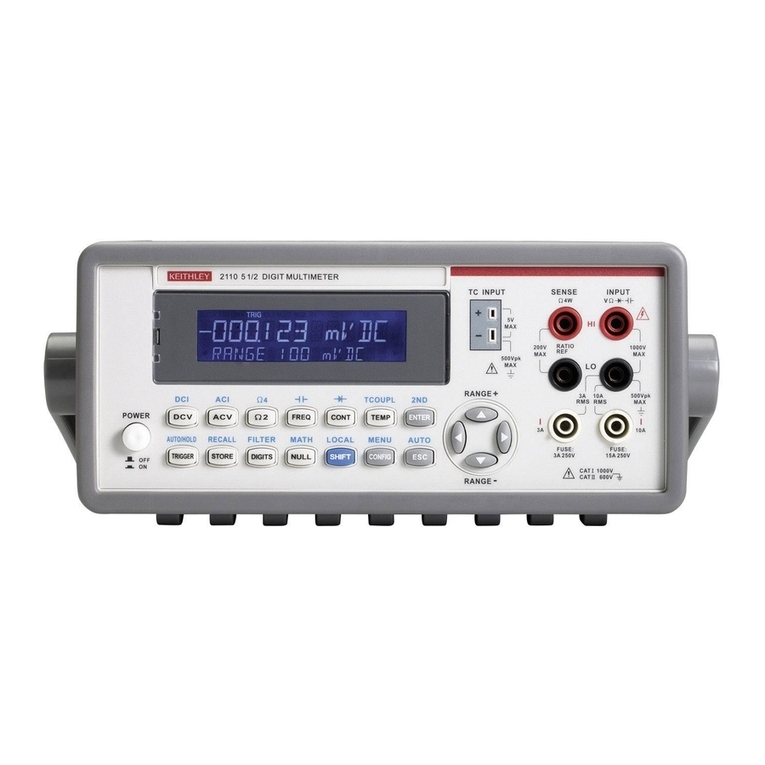
Keithley
Keithley 2110 Use and care manual
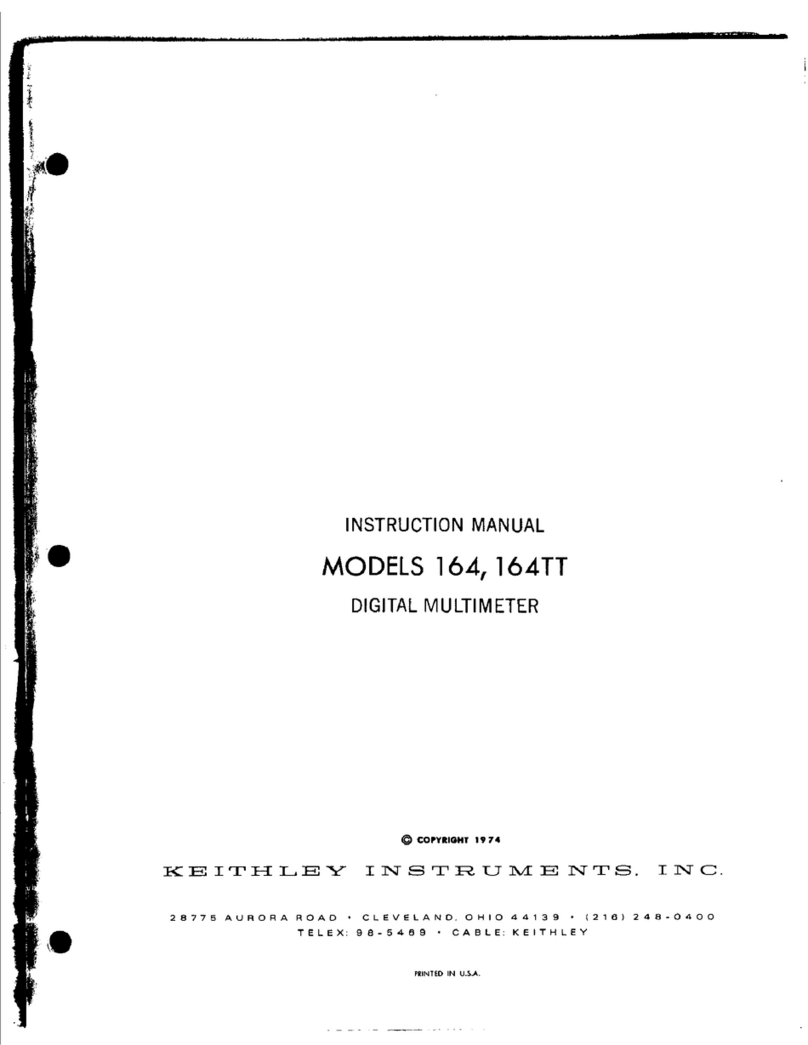
Keithley
Keithley 164 User manual
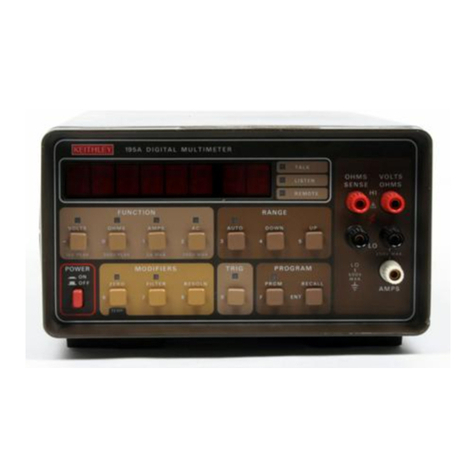
Keithley
Keithley 195A User manual
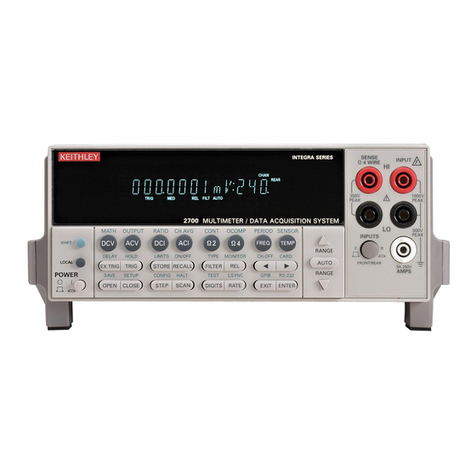
Keithley
Keithley 2700 User manual
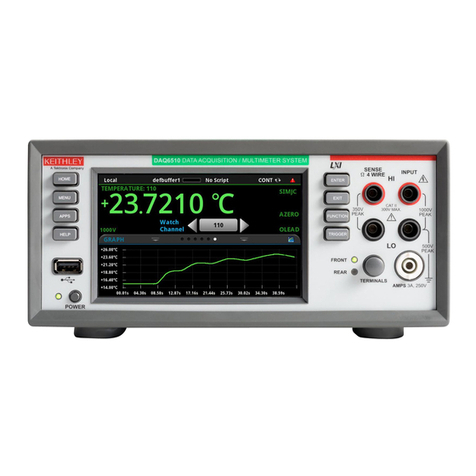
Keithley
Keithley DAQ6510 User manual

Keithley
Keithley 2000 Use and care manual
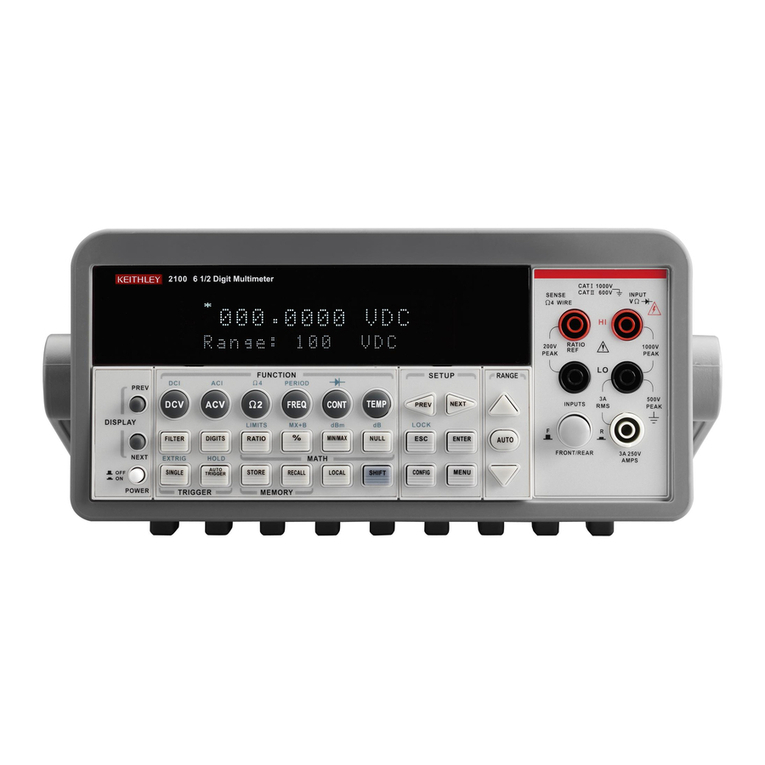
Keithley
Keithley 2100 User manual
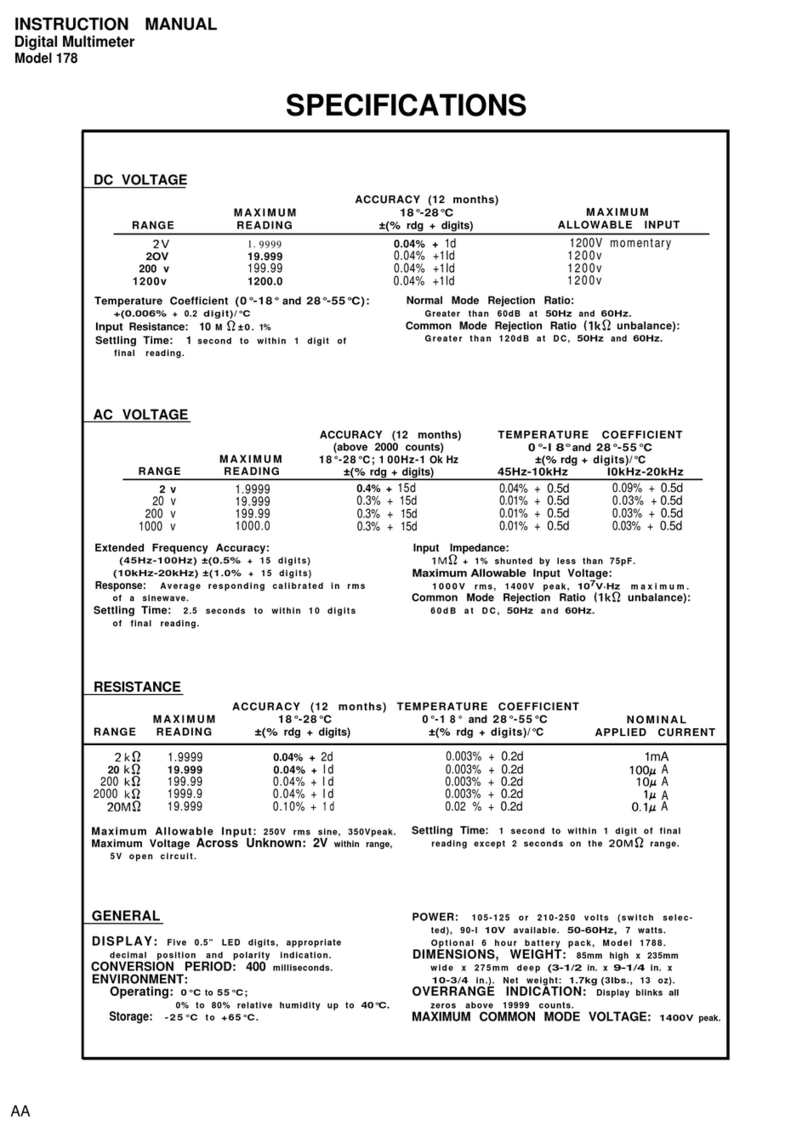
Keithley
Keithley 178 User manual
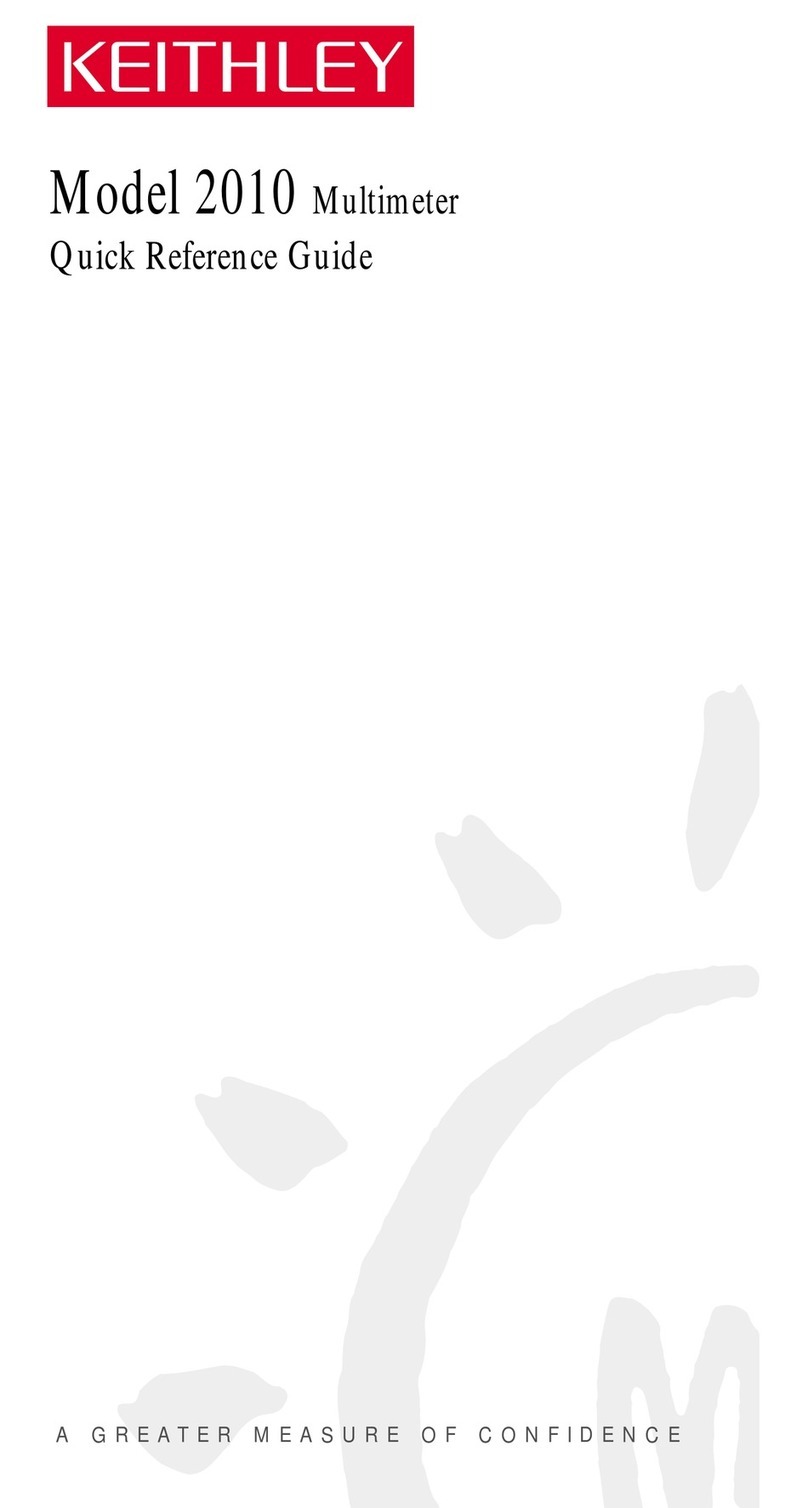
Keithley
Keithley 2010 User manual

Keithley
Keithley DMM7510 User manual
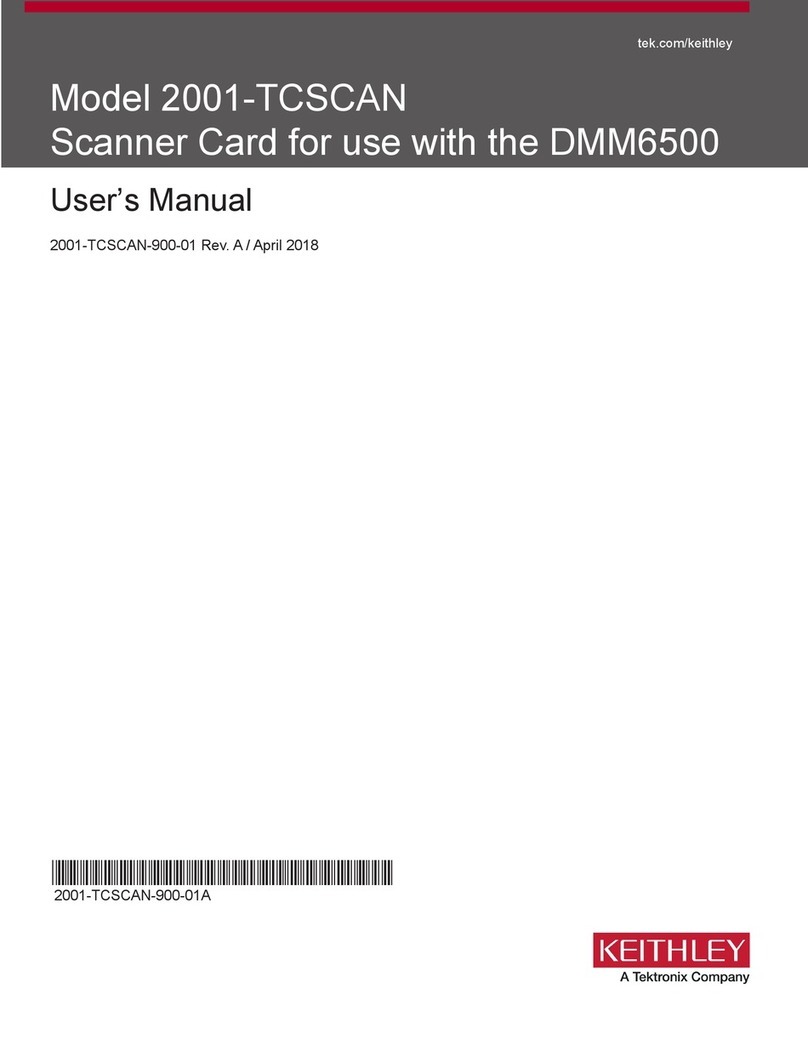
Keithley
Keithley 2001-TCSCAN User manual
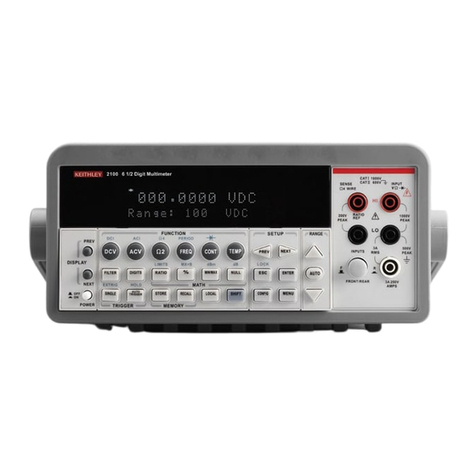
Keithley
Keithley 2000 User manual

Keithley
Keithley 197 User manual

Keithley
Keithley 2110 User manual

Keithley
Keithley 172A User manual
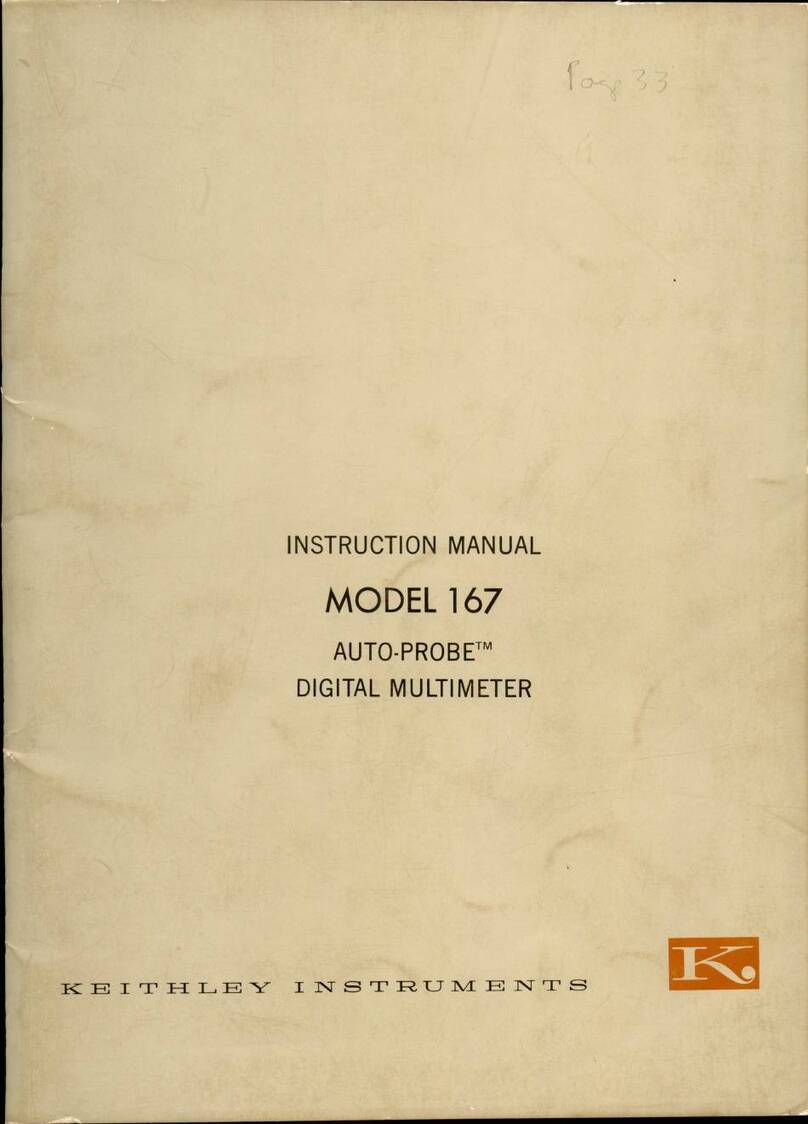
Keithley
Keithley AUTO-PROBE 167 User manual
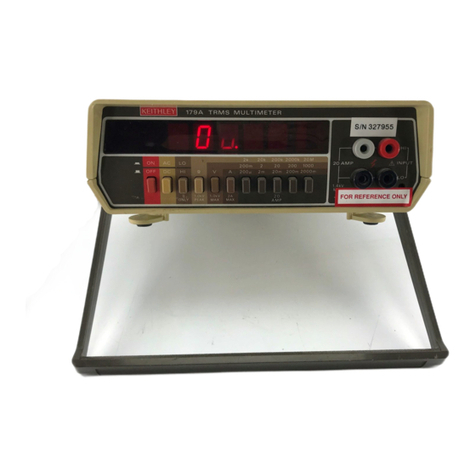
Keithley
Keithley 179A User manual
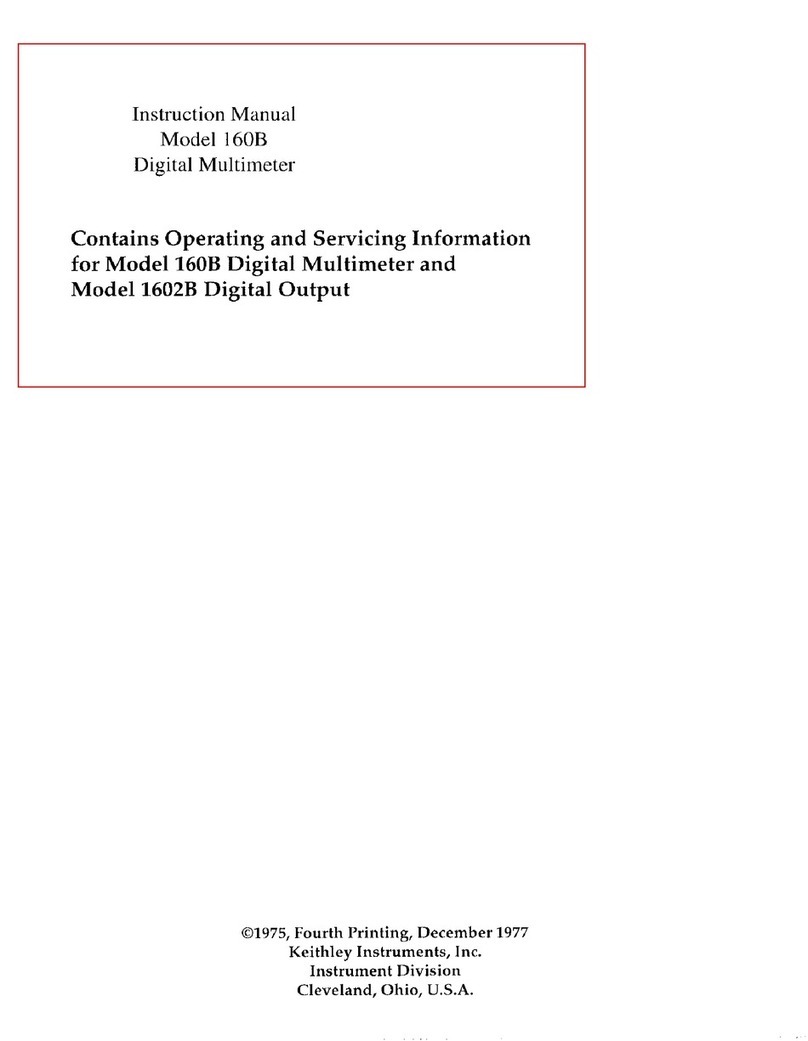
Keithley
Keithley 160B User manual
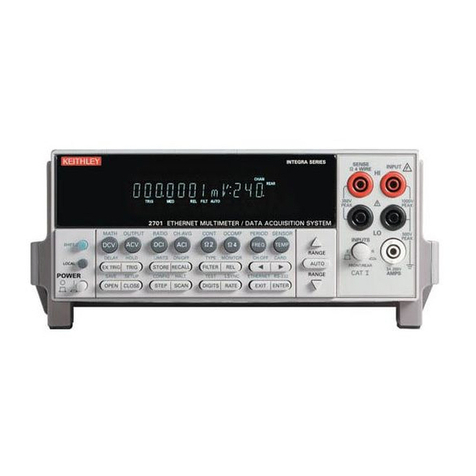
Keithley
Keithley 2701 User manual

